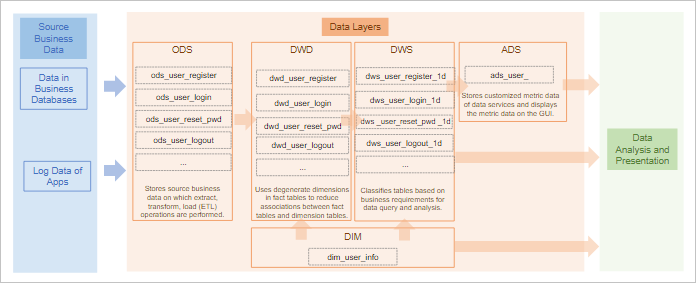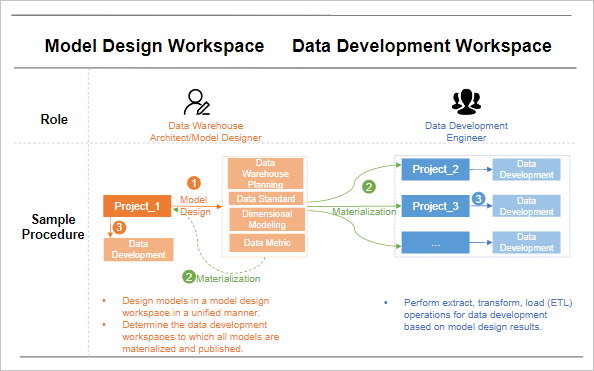When a data warehouse architect or a model group member uses DataWorks to perform data modeling, they can design data layers, business categories, data domains, business processes, data marts, and subject areas on the Data Warehouse Planning page in the DataWorks console. After the design is complete, a model designer can manage the created models based on objects such as data layers, business categories, data domains, and business processes.
Data layer
You can design data layers in a data warehouse based on business scenarios and data scenarios. By default, DataWorks creates the following common layers for you:
Operational data store (ODS)
Data warehouse detail (DWD)
Data warehouse summary (DWS)
Application data service (ADS)
Dimension (DIM)
You can create data layers based on your business requirements. For more information about how to create a data layer, see Create a data layer.
Data layer category
DataWorks provides data layer categories such as data import layer, common layer, and application layer. You can create different data layers of these categories and allow the system to display the data layers in a hierarchical structure. The following figure shows the five default data layers that are provided by DataWorks Data Modeling. After data layer planning is complete, you can create tables at different data layers based on your planning.
Data import layer: A data import layer is used to store basic raw data such as database data, logs, and messages. After raw data is processed by various extract, transform, and load (ETL) operations, the raw data is stored at a data import layer. You can store only operational data store (ODS) tables at a data import layer.
Common layer: A common layer is used to process and aggregate common data that is stored at a data import layer. You can create a unified metric dimension and create reusable fact data and aggregate data that are used for data analysis and collection at a common layer. You can store fact tables, dimension tables, and aggregate tables at a common layer.
Application layer: An application layer is used to store data that is processed and aggregated at a common layer. You can store statistical data that is collected in specific application scenarios or for specified products at an application layer. You can store application tables and dimension tables at an application layer.
Business category
If your business is complex and needs to share the same data domain, you can categorize the business, plan different business categories for the business, and associate the business categories with dimension tables and fact tables during subsequent data modeling. This helps you quickly locate data of business during model design and application. For more information about how to create a business category, see Business category.
Data domain and business process
In most cases, data domains and business processes belong to a common layer. You can categorize data at a common layer into different data domains and business processes based on dimensions such as the business category, source, and purpose of data.
Data domain
A data domain is a high-level data classification standard. It is a collection of business processes that are abstracted, refined, and combined. A data domain is the first data grouping entry for business personnel. It helps business personnel quickly locate the desired business data from large amounts of data.
For more information about data domains, see Data domain.
Business process
A business process is used to describe the process of a business activity, such as adding commodities to the shopping cart, placing an order, or paying for an order. Business processes have typical application during business effect analysis, such as funnel analysis of commodity purchases. You can break down a commodity purchase into the following business processes: browsing commodities, adding commodities to the shopping cart, placing an order, paying for the order, and confirming the receipt of a commodity. Use the number of orders as a metric for each business process and perform funnel analysis on the metric. For more information about how to create a business process in DataWorks, see Business process.
Data mart and subject area
In most cases, data marts and subject areas belong to an application layer. Data marts and subject areas allow you to categorize a specific type of business by scenario or product in a fine-grained manner, determine different analysis perspectives, and collect statistical data based on your business requirements and data that is aggregated at a common layer.
Data mart
A data mart defines business subjects for a business category. You can categorize data in a data mart into different subject areas based on various analysis perspectives. Data marts are used to collect statistics on business applications and analyze the statistics. For example, you can create a data mart to collect statistics on an operations platform and analyze the statistics.
For more information about data marts, see Data mart.
Subject area
A subject area is a collection of business subjects that are closely correlated with each other. A subject area is used to divide a data mart from various analysis perspectives. You can classify business subjects into different subject areas based on your business requirements. For example, you can create a transaction subject area, a member subject area, and a commodity subject area for e-commerce data. For more information about subject areas, see Subject area.
Dimension management
Dimension management allows you to define dimensions in a standard manner and construct and manage dimensions that are generated during data modeling in a centralized manner to ensure the uniqueness of dimensions. When you create a dimension table, you can associate the dimension table with a dimension. After the association, you can analyze and present the business data stored in the dimension table from the dimension. For more information about dimensions, see Create a conceptual model: dimension.
Modeling workspace
If your data system involves multiple workspaces and you want to use the same data warehouse plan for these workspaces, you can use the modeling workspace feature. This feature allows you to plan data warehouses, perform dimensional modeling, and define metrics for the workspaces in a unified manner.
DataWorks provides model design workspaces and data development workspaces to help you use the modeling workspace feature to generate and apply models across workspaces.

For more information about the modeling workspace feature, see Modeling workspace.